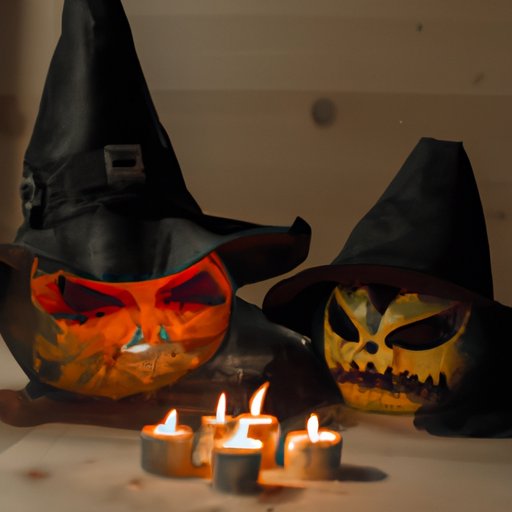Introduction
As the leaves start to change colors and the air becomes crisp, Halloween decorations start popping up everywhere. But have you ever wondered why we celebrate Halloween? Why do we dress up in costumes, carve pumpkins, and go trick-or-treating? For many people, Halloween is a beloved holiday, but few understand the history and significance behind the traditions. In this article, we will explore the origins of Halloween, how it is celebrated in different cultures, the psychological thrills of the holiday, its commercialization, and more. By the end, you’ll have a new appreciation for this spooky holiday.
The History of Halloween
The origin of Halloween can be traced back to the ancient Celtic festival of Samhain. On this day, people would light bonfires and wear costumes to ward off ghosts. The Romans later adopted this festival, and it eventually became All Saints’ Day, a day to honor saints and martyrs.
In Mexico, a similar holiday called Day of the Dead is celebrated on November 1st and 2nd. This holiday is a time to remember loved ones who have passed away and to help them on their spiritual journey. In some parts of Europe, another similar holiday called All Souls’ Day is celebrated on November 2nd.
Over time, Halloween has evolved into the holiday we know today, with pumpkin carving, parties, and trick-or-treating as mainstays of the celebration. The reasons for celebrating Halloween have also changed – instead of warding off ghosts, it has become a holiday to celebrate the spooky and the supernatural.
The Significance of Halloween in Different Cultures
While Halloween is mainly associated with the United States, it is celebrated in many parts of the world. In Ireland, where Halloween originated, they still celebrate with bonfires and other traditional customs. In Mexico, Day of the Dead is a time for family gatherings and feasts. In China and Hong Kong, Yue Lan or Festival of the Hungry Ghosts is celebrated.
Despite cultural differences, there are many shared aspects of Halloween around the world – costumes, candy, and spooky decorations are all part of the holiday. Many people also incorporate their own cultural traditions into Halloween celebrations. For example, some people in the United States include elements of Dia de los Muertos celebrations in their Halloween decorations and celebrations.
The Psychological Thrill of Halloween
Humans have long been fascinated by horror and suspense. The adrenaline rush that comes from a scary movie or haunted house can be addictive for some. But why do we love to be scared?
One theory is that the fear response triggers our fight or flight response and releases endorphins in our brains. These endorphins can create a euphoric feeling, which can be addictive. Additionally, humans have evolved to be wary of dangerous situations, so our brains are wired to be hyper-alert to potential threats, even if they are not real.
Halloween capitalizes on these instincts by creating an immersive environment of spooks and scares. Whether it’s a haunted house or a horror movie marathon, Halloween provides an opportunity to experience fear in a controlled environment.
The Commercialization of Halloween
Halloween is big business – according to the National Retail Federation, Americans spent $8.8 billion on Halloween in 2019. Brands have capitalized on the popularity of the holiday with creative marketing strategies that range from pumpkin spice-everything to pop-up Halloween stores.
One of the biggest markets for Halloween is costumes. From superheroes to spooky monsters, people spend big money on costumes each year. In recent years, there has been a trend towards more unique and creative costumes, with pop culture characters and DIY costumes becoming more popular.
The Real-Life Inspirations Behind Halloween
Many Halloween costumes and decorations are inspired by real-life events, legends, and myths. For example, the legend of Dracula has inspired many vampire costumes, while ghost stories have inspired spooky decorations like haunted houses and fake cobwebs.
While these inspirations are often seen as purely for entertainment, they can have cultural and historical significance. For example, the legend of La Llorona, a woman who weeps and wails for her lost children, is a significant part of Mexican culture and has inspired many Day of the Dead celebrations.
The Social Significance of Halloween
At its core, Halloween is a holiday that brings people together. Trick-or-treating and costume parties are a chance to connect with friends and neighbors, while Halloween parades and festivals provide a sense of community.
Shared experiences like these can build connections and friendships that last beyond the holiday. For children, Halloween can also provide a sense of wonder and creativity, as they get to dress up and use their imaginations in new ways.
Conclusion
While it’s easy to get caught up in the fun and thrills of Halloween, it’s important to understand the history and cultural significance of the holiday. From its ancient roots to its modern-day commercialization, Halloween is a multifaceted celebration that connects people across cultures and backgrounds. By understanding the reasons behind the holiday, we can approach it with a new perspective and appreciate its unique and spooky elements even more.
If you’re looking to spice up your Halloween celebrations this year, try incorporating some new traditions or costumes – you never know what you might discover.
